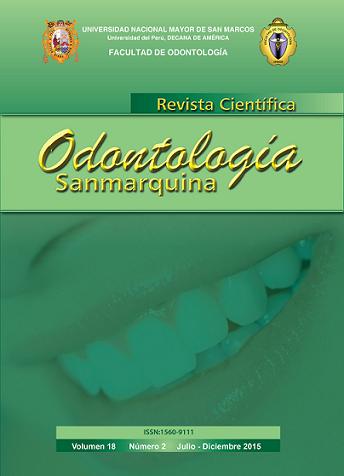Growth direction, position and size of the jaws in open bite of skeletal class II and III malocclusion
DOI:
https://doi.org/10.15381/os.v18i2.11518Keywords:
Open bite, Ricketts’ analysis.Abstract
The aim of the study was to determine the growth direction, position and size of the maxilla and mandible
with skeletal open bite Class II and III. Methodology: This is an observational, descriptive and
cross-sectional investigation. The population consisted of 100 lateral cephalometric radiographs of patients
with clinical diagnosis of skeletal open bite. The sample was not probabilistic for convenience. The
Nemoceph program was used for Ricketts analysis to get the values of variables. The sample consisted
of 36 radiographs of skeletal open bites. The data obtained were analyzed with the chi-square test at a
confidence level of 95% equivalent to 1.96 and a margin of error of 5%. Results: Of the 36 open bites,
72.2% were class II and 27.8% Class III skeletal pattern. The two groups showed mostly normodivergent
growth direction in the maxilla but all the mandibles showed hyperdivergent growth. In relation to
position, both groups had normal position of the maxilla, but differed in size, being normal size for class
II group and increased size for Class III. With respect to mandible, both groups showed decreased size,
but differences in position, being a retruded position for class II group and a normal position in class III
group. Conclusion: There were no significant difference, p<0.05, in the growth direction, position and
size of maxilla and mandible in skeletal patterns of class II and class III.
Downloads
Downloads
Published
Issue
Section
License
Copyright (c) 2015 Lisbeth Pérez Cahuaya, Karla Valdez Castro, Roxana Delgado Llancari, Luis Pérez Vargas, Carlos Tisnado Florián

This work is licensed under a Creative Commons Attribution-NonCommercial-ShareAlike 4.0 International License.
AUTHORS RETAIN THEIR RIGHTS:
a. Authors retain their trade mark rights and patent, and also on any process or procedure described in the article.
b. Authors retain their right to share, copy, distribute, perform and publicly communicate their article (eg, to place their article in an institutional repository or publish it in a book), with an acknowledgment of its initial publication in the Odontología Sanmarquina.
c. Authors retain theirs right to make a subsequent publication of their work, to use the article or any part thereof (eg a compilation of his papers, lecture notes, thesis, or a book), always indicating the source of publication (the originator of the work, journal, volume, number and date).




















